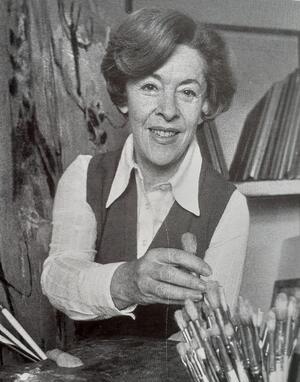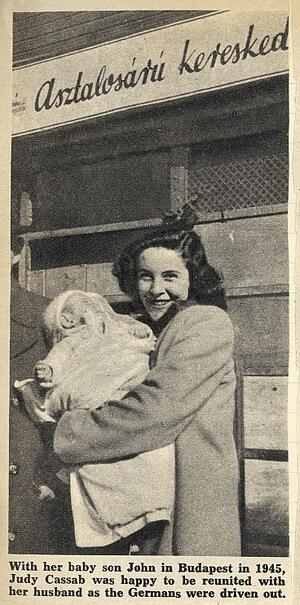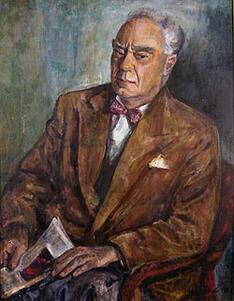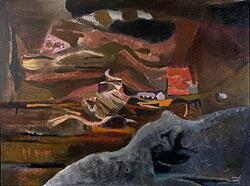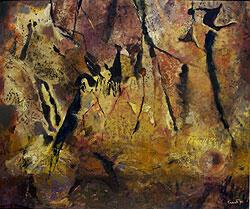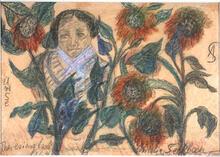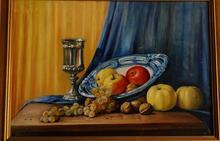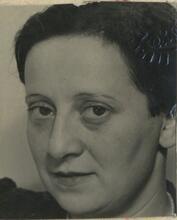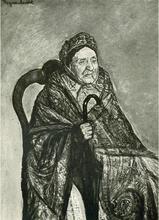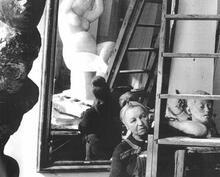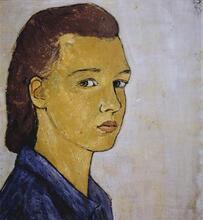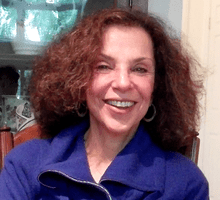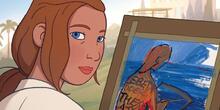Judy Cassab
Vienna-born, Budapest-trained painter Judy Cassab, who survived the Holocaust with the help of her non-Jewish maid's identity papers, arrived in Australia in 1951 with her husband and their two small sons. She became one of the country’s best-known and best-loved artists, primarily for her portraits but also for her depictions of Australia's bright interior. She was the second woman to win the Archibald Prize, Australia's most prestigious award for portraiture, and forged an international reputation. Her sitters including prominent Britons and other notables abroad.
Surviving the Holocaust
Born Judit Kaszab on August 15, 1920, Judy Cassab was born in Vienna, the only child of middle-class Hungarian Jewish parents Imre and Ilona (Kont) Kaszab. She grew up in Beregszász, a town with a large Hungarian population; now in Ukraine, and in Soviet Russia after the Second World War, it was at that time in Czechoslovakia. She graduated from school there in 1938.
While in her teens Cassab fell in love with Jancsi Kaempfner, a Jewish chemical engineer and brewery manager twice her age. They resolved to wed, but first, having been left with no illusions regarding her innate need to make painting part of her life, he prevailed on her to go to Prague to study it for a year. She missed him terribly, and in 1939, following the Nazi invasion of Prague, she returned home and they were married. Jancsi was sent to a forced labour camp in Russia in 1941, and, again at his urging, for he would always be supportive of her artistic ambitions, she went to art school in Budapest. There, she studied under the eminent Aurél Bernàth.
Jancsi was released after two years. Living separately for fear of discovery, the couple managed to survive the Nazi occupation, Cassab assuming the identity of her former maid, a non-Jew who insisted on this step. Both Cassab and Kaempfner lost close family in the Holocaust, with her mother’s death at Auschwitz (her father had died years earlier) preying on Judy’s mind for the rest of her life.
Having lived in Hungary under first German and then Soviet rule, Cassab and Kaempfer escaped in 1949 to Vienna but soon decided to leave Central Europe altogether. They arrived in Sydney in 1951 with their sons aged six and four, living at first in a boarding house in the seaside suburb of Bondi. Judy spoke no English, but she carried a letter of introduction to businessman, artist, and art patron Sir Charles Lloyd Jones, who commissioned her to paint his wife Hannah.
Building a Reputation
In 1955, the Australian Women's Weekly introduced an art prize, at the time the most lucrative ever offered in the country. Destined to be given annually for just a few years, it guaranteed that a woman would, at the very least, come second. The sum of $A1500 was awarded to the artist of what, in the opinion of the judges (the directors of Australia's state art galleries), was the best portrait—in oils, watercolor, or pastels—of a woman, a woman with a baby or child up to ten years of age, or a child aged fourteen years or less. Another sum of $A500 would be awarded to the best such portrait by a woman artist; if a woman won first prize, she would pocket this prize too.
Entries came from both Australia and overseas. Cassab, who that year also won the Pring Prize from the Art Gallery of New South Wales, took the $500 prize with her portrait of fashion model Judy Barraclough; she won again in 1956 with her portrait of artist Elaine Haxton.
In 1959 Cassab paid her first visit to the geographical heart of Australia, where she was overwhelmed by the unfamiliar landscape, with its searing, enticing, unfamiliar brightness and vivid colors. Later that year she sold many of those paintings at an exhibition at the Crane Kalman Gallery in London; this exhibition was favorably reviewed in major British dailies such as The Times and The Observer. The gallery’s owner was also a Holocaust survivor from Hungary. Cassab, who, it transpired, had once socially met his father, a chemist who had perished at Auschwitz, had been put in touch with him by an Australian influential in the art world, a former art critic of the Sydney Sun who now co-owned the prestigious Redfern Gallery in London.
In time, further familiarity with the central Australian landscape, above all the awe-inspiring great rock known to the indigenous people of the area as Uluru, a place of immense spiritual significance to them, captivated Cassab; she marvelled at its forms, which reminded her of the sculptures of Henry Moore, the faces of the Sphinx, and other icons of legend she fancied she saw in it and considered it a place of wonderment. She returned to paint it and its surroundings again and again, telling herself that at last she had found the reason fate had brought her to Australia.
Consolidating a Reputation
Meanwhile, during her 1959 exhibition Cassab had also sold a study of a woman's head to a director of a major shipping company, the Orient Line. It caught the eye of the company's director, Sir Colin Anderson, who also happened to be chairman of London's Tate Gallery. He was so impressed with it and with photographs of portraits by Cassab that he arranged for her to depict Queen Elizabeth II's cousin Princess Alexandra, who was due to launch the company's new vessel the Oriana. That portrait was undertaken at Buckingham Palace in 1960.
Cassab also had several other commissions to fulfill in London as a result of the 1959 exhibition. She established a fine reputation there as a portraitist and over a number of years took to spending a couple of months annually in London executing commissions, while her husband cheerfully remained in Sydney looking after the couple’s sons. Her sitters in Britain included such notables as top fashion model Barbara Goalen, movie star Valerie Hobson, Conservative Party politician Sir Peter Thorneycroft (who had held office as Chancellor of the Exchequer), and Labour Party leader Hugh Gaitskell.
In 1961 Cassab became the second Australian woman (the first was in 1938) to win the Archibald Prize, for her portrait of fellow painter Stanislaus Rapotec, a portrait more modernistic in style than previous winners. She won the Archibald again in 1967 with her portrait of artist Margo Lewers. Over the years, she painted a large number of distinguished Australians, male and female, from a variety of fields ranging from the stage to academia, as well as foreign dignitaries and rulers.
In 1964 and again in 1971 Cassab won the Sir Charles Lloyd Jones Memorial Prize; in 1965 she won the Helena Rubinstein Prize. In 1969, when so-called “imperial honours”—those awarded by Queen Elizabeth II as head of the British Commonwealth of Nations—were still given out in Australia, she was awarded the CBE (Commander of the Order of the British Empire) for her “service to the visual arts.” In 1988, the radical Whitlam government having replaced imperial honors to Australians by honors awarded by Australia itself, she was made an AO (Officer of the Order of Australia), also for “service to the visual arts.” In 1994 and again in 1997 she received the Pring Prize from the Art Gallery of New South Wales. Her diaries, published in 1995, won her the Nita B. Kibble Award for Women Writers in 1996. The University of Sydney awarded her an honorary Doctor of Letters in 1995, and in 2011 Hungary awarded her its Gold Cross of Merit.
A widow from 2001, and suffering age-related dementia for fourteen years, Cassab died of cancer on November 3, 2015.
Bulletin, August 19, 1967, 12.
Canberra Times, June 4, 1960, 13; January 28, 1961; January 20, 1968, 1; June10, 1964, 20; October 13, 1083, 21; May 5, 1084, 17; July 15, 1994, 12; November 12, 1995, 19.
Cassab, Judy. Australian Portraits: ten official lithographs, Sydney: Beagle Press: 1984.
Cassab, Judy. Diaries. Sydney: Alfred A. Knopf, 1995.
Hebrew Standard of Australasia, May 4, 1953, 4.
“Interview with Judy Cassab,” in Lee Jobling and Catherine Runcie, Matters of the Mind: Poems, Essays and Interviews in Honour of Leonie Kramer, Sydney: University of Sydney: 2001), 129-144.
Klepac, Lou. Judy Cassab: Portraits of Artists and Friends. Sydney: Beagle Press, 1998.
Niall, Brenda. Judy Cassab. Crow's Nest, NSW: Allen & Unwin, 2005.
https://www.nowtolove.com.au/celebrity/celeb-news/pioneering-female-art…
Rubinstein William D. The Jews in Australia: A Thematic History. Volume Two: 1945 to the Present. Port Melbourne: William Heinemann Australia, 1991.
Sydney Morning Herald, April 22, 1953, 2.

